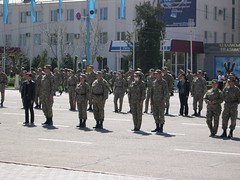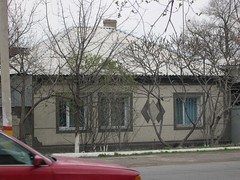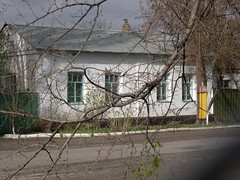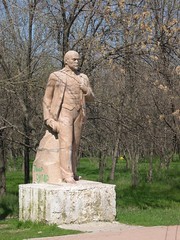Taraz
Taraz (; known to Europeans as Talas) is a city and the administrative center of Jambyl Region in Kazakhstan, located on the Talas (Taraz) River in the south of the country near the border with Kyrgyzstan. It had a population of 330,100 as of the 1999 census, up 9% from 1989, making it one of the fastest-growing cities in the country, after Astana and Turkistan.
One of the oldest cities in Kazakhstan and in Transoxania, built and populated by the ancient Sogdians, Taraz celebrated its official 2,000th anniversary (recognized by UNESCO) in 2001, dating from a fortress built in the area by a Xiongnu Chanyu named Zhizhi, and was a site of the Battle of Zhizhi in 36 BCE. The city was first recorded under the name "Talas" in 568 CE by Menander Protector. The medieval city of Talas was a major trade centre along the Silk Road. Talas was later described by Buddhist monk and traveller Xuanzang, who passed Talas in 629 and later wrote: "Traveling westward from the Thousand Springs 140 or 150 li, we come to the city of Daluosi. The city is 8 or 9 li in diameter; and was settled by Hu ("foreign, barbarian, non-Chinese") merchants from various nations. The products and the climate are about the same as Suyab." The Talas alphabet, a variant of the Turkic "runiform" Orkhon script, is named for the town.
Talas secured a place in history by virtue of the Battle of Talas (751 CE), which was fought between forces of the Chinese Tang dynasty and those of the Arab Abbasid Caliphate. The battle took place somewhere along the Talas River in the Talas valley. One of its indirect outcomes was the introduction of paper to the West, via the Arab capture of Chinese paper makers.
History
Overview
Numerous archaeological finds and monuments in the foothills of Karatau and in Talas-Assin oasis show the antiquity of settlements in the Talas River valley, supporting Taraz's claim to being the most ancient city in Kazakhstan. The history of the city is composed of several historical periods, interrupted by destruction and depopulation. The first reference historically recorded city linked with Taraz and the basis for the claim of 2000-year-old history is the fortress of Zhizhi that briefly existed at the site of modern-day Taraz in the 1st century BCE. A city known as "Taraz" (or "Talas") is then recorded in the 6th century CE (568 CE) and is known to have existed until its decline in the 13th century. The third historical period begins with the establishment of a Kokand fortress at the end of the 18th century, which in 1864 was named Auliye-Ata (from the Uzbek words meaning saint and father). In 1936, the city was renamed Mirzoyan (Russian), after Levon Mirzoyan. After Mirzoyan's arrest in 1938, the city was renamed to Dzhambul (Russian), after the Kazakh traditional folksinger Jambyl Jabayev (Dzhambul Dzhabayev). In 1993, the spelling of the city's name was officially changed to Jambyl/Dzhambyl (Kazakh: , Jambyl), and in 1997 the city was renamed Taraz.
The city started to assume its present form when Colonel Chernyev's detachment took over the Aulie Ata fortress and annexed it to the Russian Empire, starting in 1864. Taraz was greatly improved by the Semirechensky railway that passed through the town in 1917.
Prehistoric times
Discovery of caves and ancient campsites during the investigation of the eastern part of the Talas-Assinsky Oasis, in the Karatau Ranges spur has confirmed Bernshtam's opinion (expressed in 1903) that the Talas Valley was settled before the 1st century BC: "It is doubtless that the continuation of valley's research will give older testimonies of man's stay." Remnants of material culture that were found during excavation of Taraz speak about the lifestyle in this territory to the Neolithic period.
Antiquity
The discovery of chest ornaments, bronze statues of kings and remnants of ceramic products in separate parts of the Talas river valley are the evidence of the existence of the life in Taraz region in the bronze epoch. According to the archaeological excavation and available written sources, tribal unions of Saka Scythians had been formed in this territory by the 7th-8th centuries B.C.
Hanshu, 70 from 1st-century, talk about the fortress constructed on Talas River by Zhizhi Chanyu, a prince of Hun (Ch. Xiongnu, Hsiung-nu, etc). The fortress is believed to have been at the site of modern Taraz.
Medieval Taraz
Islamic and Persian period
This is the site of the "Battle of Talas"—first and the last military face-off between the Muslim Arab forces and the Chinese imperial troops in AD 750–51. After the Arab conquest of Central Asia in the 7th century and 8th century, the Persian Samanids occupied a major part of Central Asia in the 9th century. By this time Taraz, developing little by little had been a rich city-state typical of Central Asia with a large population and vast agricultural zone. In the late 9th century the Samanids extended their rule into the Steppes and captured Taraz (893), then one of the headquarters of the Karluk kaghan. A large church was transformed into a mosque, and according to one source, the "Amir of Taraz" embraced Islam. The Islamization of Central Asia was due in significant part to the activities of the Samanids, and in Taraz, other pre-existing religions such as Mazdaism, Christianity, Buddhism, and Tengrism were gradually replaced.
The Karakhanids
The Persian Samanids however were defeated by the Turkic Karakhanids who were a confederation of Karluks, Chigils, Yaghmas and other tribes. The Karakhanids were the first Turkic groups to have converted to Islam en masse, and from the 10th to 12th century Taraz was ruled by the Kara-Khanid Khanate as a Muslim state. By the 10th century Taraz had acquired the distinctive features of Central Asian city . Ancient Taraz reached the climax of its development in 11th-12th century under the Karakhanids. Instead of more or less centralized state like the Samanids, Karakhanid Central Asia was divided into many small fiefdoms or appanages. Taraz became an important centre. The political independence of Taraz and autonomy of the circle promoted their development. The power of the city under one of the rulers, Tugan-Khan, was so great that he independently waged a military campaign against Samarkand and temporarily captured it. Kashgar was invaded and it was under the Taraz's power during 15 months. Certainly, this political power was the result of the economic importance of the city. In the Karakhanid Era the main part of Taraz, the Shahristan and Arg, did not grow beyond their sizes in the previous Qarluq-Samanid Era. The Arg lost its main significance in the city's life. The Shahristan became the heart of economic and cultural life of the city. It was there that all the military, administrative, cultural and other establishments that governed life in the medieval feudal city-state took place. At this time in the city and its countryside the mausoleums of Aisha-Bibi and Karakhan were built. Taraz had an underground water system made of terracotta pipes, paved streets, and sewage collection. Of great interest is the Taraz Banya, which was multiple-domed building built from fired brick. In due course under the influence of internecine wars the Karakhanids lost their power and in the end of the 12th century the city was taken by the Kara-Khitans. In 1210 Kara-Khitans were defeated by Khwarazmshah Mohammed.
Mongols
Karakhanid rule did not last long because in 1220 nearly all Central Asia and the territory of modern Kazakhstan were invaded by Mongols. There were no written documents about Taraz's growth under the Mongols after they razed it to the ground. Remnants of fire found during the excavation show that the city was burnt. Probably the town was renamed as Yany ('New'); while mentioning it, European and Arabic sources write "The city Yany, named Taraz before the conquest." Archaeological finds show that the once-lively city under the Mongolian yoke lost its previous significance and independence. The blooming of settled life in Taraz ended and decline began. Under the Chagatayids (descendants of Chagatai Khan) coins were minted in Taraz until 1334. The Tsareviches, who, as Vasa of 14th century states, "burnt the Golden Horde, destroyed Taraz and other cities, and killed the population. They took everything they could take, and burnt the rest. There was a mention of the city again in 1345 in the road guide book as a city laid on the trade route from Transoxiana to Almalyk."
Steady internecine war in Central Asia interfered with the trade with distant countries, and the opening of the sea route from the Western European countries to India stopped the trade on the ancient silk road and led to the decline of the cities on this road.
Kazakh rule
Taraz is mentioned again in 1513 with the coming of the Kazakh tribes. The once famous medieval city and former capital had become a simple settlement, then it was forgotten, as well as its ancient name. By the 16th century the city's territory had been absorbed into the Kazakh Khanate. The archaeological excavation shows Kazakh nomads were involved in the rebirth of Taraz with cultural links connecting the ancient medieval city with the culture of Kazakh people . The confirmation of it is the names of artificial channels stretched from the city. Under the Kazakh Khans in ancient Taraz there was just a small settlement, the inhabitants of which were engaged in craft, agriculture and cattle breeding. In 1723 the Talas Valley, as well as the major part of southern Kazakhstan were invaded by Dzungars who owned it nearly until 1755.
Qing rule
After the Dzungars were eliminated by Qing China in 1755, their entire territory, including Talas area, was annexed by the Qing, Qing soldiers patrolled the area once a year. Kazakh people were expelled from the area if they were captured pasturing inside the area.
As a result of the Dzungars' destruction the area became a No man's land, Qing China had to deal with consistent cross-border immigr…
Hotels Taraz
Looking for places related to Taraz?
Those are other destinations to find places related to Taraz:
































